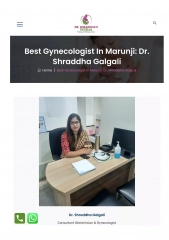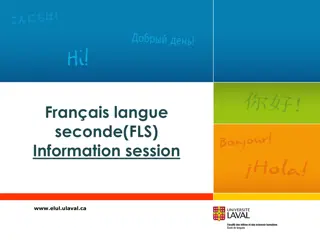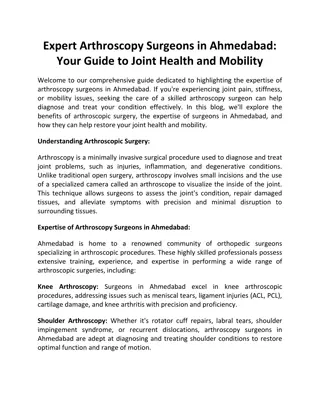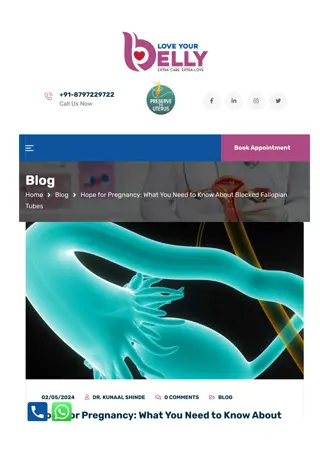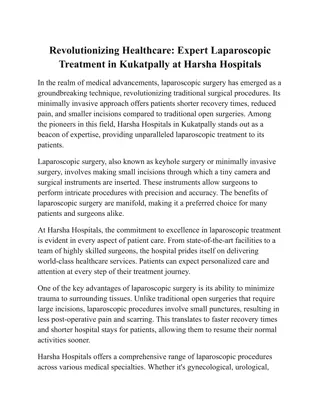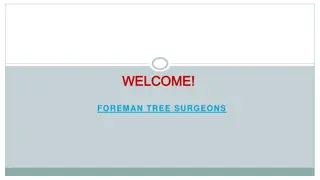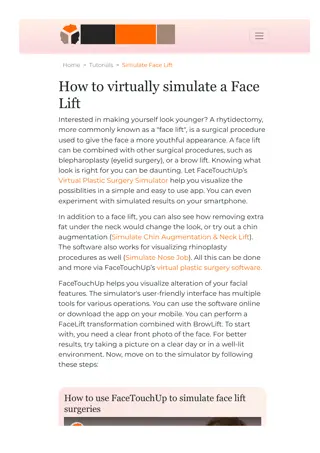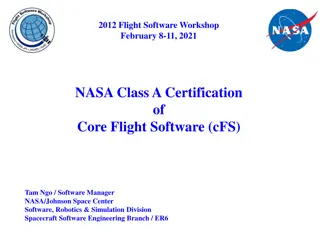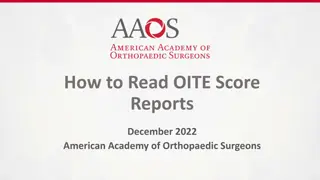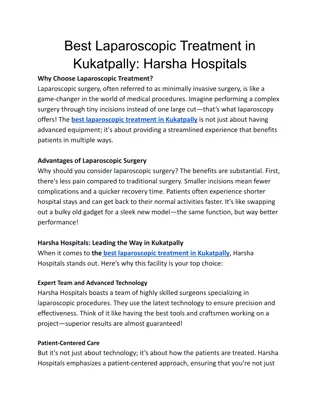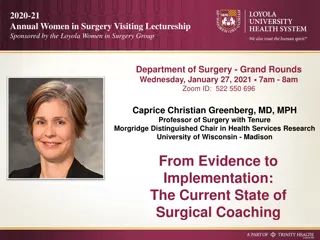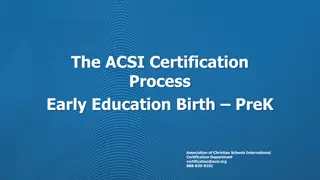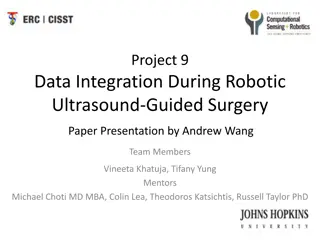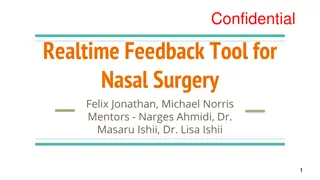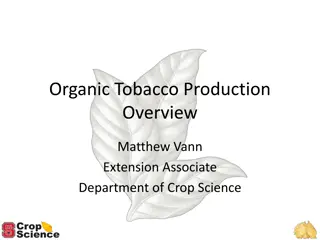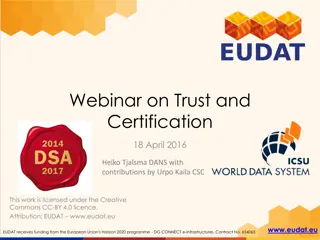Comprehensive Overview of FLS Certification Program for Laparoscopic Surgeons
Explore the FLS certification program covering essential aspects such as equipment familiarity, patient care considerations, physiology of pneumoperitoneum, laparoscopic suturing, and more. Dive into the requirements, written examination details, manual skills proficiency, and tasks involved in the certification process.
Download Presentation

Please find below an Image/Link to download the presentation.
The content on the website is provided AS IS for your information and personal use only. It may not be sold, licensed, or shared on other websites without obtaining consent from the author.If you encounter any issues during the download, it is possible that the publisher has removed the file from their server.
You are allowed to download the files provided on this website for personal or commercial use, subject to the condition that they are used lawfully. All files are the property of their respective owners.
The content on the website is provided AS IS for your information and personal use only. It may not be sold, licensed, or shared on other websites without obtaining consent from the author.
E N D
Presentation Transcript
FLS OLIVER VARBAN, MD
Objectives Familiar with equipment Patient considerations, anesthesia, positioning Physiology of pneumoperitoneum Abdominal access and trocar placement Laparoscopic suturing Biopsy techniques and homeostasis Exiting the abdomen, postoperative care
FLS Requirements Written examination Didactics Manual skills Peg board transfer Pattern Cutting Endoloop Intracorporeal knot tying Extracorporeal knot tying
Written Test On the computer Multiple choice 75 questions 90 minutes
Manual Tasks Peg transfer Pattern Cut Endoloop Extracorporeal suturing Intracorporeal suturing 30-45 min of test taking
Manual Tasks - Proficiency Peg Transfer Two Marylands Left to right Right to left Order doesn t matter Drops out of the field
Manual Skills - Proficiency Pattern Cut Maryland and scissors All cuts within 5mm of lines Start at a 45oon the right (arrow)
Manual Skills - Proficiency Endoloop Maryland (locking) and Endoloop Up to 1mm accuracy error allowed
Manual Skills - Proficiency Extracorporeal Suture Maryland, suture (120cm), needle driver, knot- pusher, scissors Up to 1 mm accuracy error allowed
Manual Skills - Proficiency Intracorporeal Suture Maryland, suture (12cm), needle driver, scissors Up to 1 mm accuracy error allowed
Fundamentals of Laparoscopic Surgery Proficiency Scores Task Task Name Seconds Allowable Errors Repetitions Peg Transfer 48 No drops outside the field of view 2 consecutive + 10 nonconsecutive 1 (Time limit 300 ) Pattern Cutting 98 All cuts made within 2mm of black line at all times 2 consecutive 2 (Time limit 300) Endoloop 53 No more than 1mm discrepancy from line 2 consecutive 3 (Time limit 180) Extracorporeal Suturing 136 No more than 1mm away from dots (cumulative). No knot security errors. 2 consecutive 4 (Time limit 420) Intracorporeal Suturing 112 No more than 1mm away from dots (cumulative). No knot security errors. 2 consecutive +10 nonconsecutive 5 (Time limit 600)
Practicepracticepractice Novices avg of 10 hrs of training Repetition (30min sessions):
Didactics Preoperative considerations Intraoperative considerations Basic Laparoscopic procedures Postoperative care and complications
Preoperative Considerations Equipment Energy sources OR set up Preop assessment
Know your equipment Equipment table Gas supply Suction devices Video tower Troubleshooting
Check the equipment stupid Insuflation: CO2 standard, inexpensive, readily available and does not support combustion, absorbable (other gases nitrous oxide and helium) Flow and pressure Light source (300 watt xenon), light cable must be attached to the light source and the scope prior to turning it on to avoid fires
Check the equipment stupid Pressure Flow Cause Low High Leak Low Low Empty High Low Relaxation / occlusion High High Multifactorial / Malfunction
Check the equipment stupid Blank video screen light bulb, cable connections Black dots - broken optic fibers Fuzzy focus, clean lens, defog, moisture within scope
Turn it up to annihilate please Energy sources: Monopolar and bipolar Cautery causes dessication (heat causes evaporation of water); fibrous binding of dehydrated and denatured cells of the vessel endothelium Monopolar need grounding pad, rapid surface heating with a superficial eschar and shallow depth of necrosis , smaller contact area = faster heating Bipolar tissue is placed between two electrodes and current flows between them, don t need grounding pad, lower resistant circuit, use lower energy, less surrounding necrosis
Turn it up to annihilate please Cut heat tissue quickly, water in cells is converted into steam and cells burst Steam bubble float through tissue, cutting it without making contact Coag heat is more widely dispersed, no cutting
Hazards Capacitive coupling Capacitor two conductors separated by an insulator Charge is stored from monopolar instruments to metal cannulas or scopes May occur when a plastic screw anchor is used to hold a metal trocar Use all-metal or all-plastic trocars
Hazards Direct coupling cautery comes into contact with the metal portion of an instrument Return circuit - don t coag the appendiceal stump; it will get hotter at the point of ligature then it will at the stump Tissue heating = (current / cm2)2
Other Dissection tools Ultrasound (i.e. the Harmonic) Piezoelectric transducer causes rapid vibrations (55000 per second) Moving blade mechanically denatures proteins and the result coats vessel walls Heat does not go above 80 degrees Keep an eye on the cutting blade don t bury it and don t rest it on tissues afterwards because it is hot.
Positioning Ideal ergonomics Arms 30 degrees from trunk and between 60-120 degrees at the elbow Thumbs up Hands slightly pronated
Patient Positioning Pelvis tuck on or both arms in so you can stand close to the patient Upper abdomen arms to the side, lithotomy stand between the knees Lateral decubitus use axillary roll to prevent brachial plexus injuries Modified decubitus allows you to convert to open in the supine position without moving the patient Arms out no more than 90 degrees in order to avoid brachial plexus injury Use a footboard and beanbag in order to achieve max tilt/trendelenburg
ASA Class I normal, healthy II controlled medical conditions (htn, dm) III Medical conditions with functional compromise, stable (CHF, stable angina, old MI, morbid obesity, CRF) IV Poorly controlled, significant dysfunction, unstable (COPD/CHF with active symptoms, unstable angina) V Critical condition, moribund (multisystem organ failure, HD instability, coagulopathy) VI Brain dead, organ donor.
Contraindications to Laparoscopy Absolute inability to tolerate laparotomy, uncorrectable coagulopathy, lack of training/facilities Relative generalized peritonitis, extensive prior abd/pelvic surgery, inability to tolerate anesthesia, large mass/pregnancy, incarcerated hernias, intestinal obstruction, severe pulmonary edema/cardiac disease Class IV and V will not tolerate cardiopulmonary physiology associated with pneumoperitoneum
Do the H&P!!! Complications with veress needle insertion increases with: AAA, umbilical abnormailities, HSM Stop coumadin 3-5 days before surgery Stop Plavix 7 days before surgery NSAIDS do not add any risk to laparoscopy, they do NOT need to be discontinued.
Anesthesia Local helps with parietal pain but not visceral pain associated with pneumoperitoneum Bupivicaine long acting (local anesthetic of choice at trocar sites) Use atropine or glycopyrrolate intraoperatively if bradycardia occurs secondary to pneumoperitoneum Give H2 blocker to prevent complications of aspiration LMA is controversial
Veress Incision umbilicus or LUQ Elevate the abdominal wall Hold the needle perpendicular to the abdominal wall 2 clicks Intraperitoneal check Aspiration Free flow of saline Hanging drop test
Hassan 2 cm incision Umbilical region Expose fascia and lift with Kochers Incise and place vicryls Look for injury after first trocar is placed Enteral contents, bleeding, retroperitoneal hematoma Secondary trocars must be placed under direct laparoscopic vision
Other tips Point Veress / ports away from IVC/aorta Pull the skin upwards Mark costal margin and ASIS before insufflation
Complications Pneumothorax due to pneumoperitoneum 0.1 to -0.2 % Stop insufflation, chest tube Venous air embolism 0.002% - 0.02 % Stop insufflation, evacuate pneumoperitoneum, left lateral decubitus, place central venous catheter.
Physiology of Pneumoperitoneum CO2 rapidly absorbed, easily eliminated Goes to alveoli and expelled via the lungs Is not combustible Widely available and inexpensive Measure end-title CO2 or ABG
Physiology of Pneumoperitoneum Cardiac output decreases Decreased filling pressures Increased venous resistance Worse with intraabdominal pressure>20 mmHg Increased cardiac afterload Increased MAP
Physiology of Pneumoperitoneum Urine production is a unreliable indicator of volume status during laparoscopy Increased abdominal pressure decreases renal blood flow, filtration and output Increase in renin and ADH results in oliguria Takes about 1 hour to normalize after surgery Don t volume overload CHF patients for UOP only and HD are normal, GFR effects are temporary
Physiology of Pneumoperitoneum 25-47% experience arrhythmia most common is bradycardia Peritoneal stretch increase vagal tone Limit flow rate to 1.5 L/min to prevent Stop insufflation, give volume and atropine to treat
Physiology of Pneumoperitoneum Ventilation Need to increase minute ventilation to blow off absorbed CO2 Increased abdominal pressure: decreases FRC Reduces thoracic compliance and diaphragmatic excursion Increases airway pressure Increases pulmonary vascular resistance
Physiology of Pneumoperitoneum Hypothermia 90% of cases Use warm CO2 Warming blankets BARE hugger
Exiting the abdomen Ensure hemostasis Reduce pneumo and look for venous oozing Remove each trocar under direct vision (bleeding may have been held in tamponade by trocar) Port site closures close fascia with port sites > 10mm to prevent hernias All insufflation gases should be actively removed
Basic Laparoscopic Procedures Pelvic laparosocopy tuck both arms, monitor at feet, steep trendelenberg Appendectomy tuck left arm, trendelenburg and left side down Upper abdomen monitor at side or head of table, reverse trendelenberg, retract the left lat seg of liver up with fan retractor to expose the esophageal hiatus, stomach and spleen Portahepatis place a retractor or blunt instrument through the subxyphoid port to the undersurface of the medial segment of the left lobe and lifting up Spleen left side up lateral positioning
Basic Laparoscopic Procedures Retroperitoneum kidney and adrenals lateral position, ports along the costal margin, take down right triangle ligament Examining the intestines use atraumatic graspers, keep tips in view to avoid enterotomy, handle the mesenteric fat rather than the bowel wall; with bowel obstruction start at ileocecal valve and work the opposite direction (harder when bowel is dilated because your view will be limited)
Diagnostic Laparoscopy Minimally invasive access to the entire abdomen Improved sensitivity compared to radiographic imaging Magnified, illuminated view Patient positioning and exposure are key


